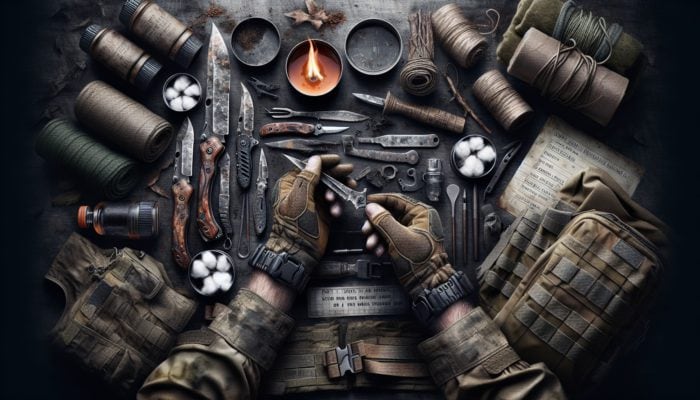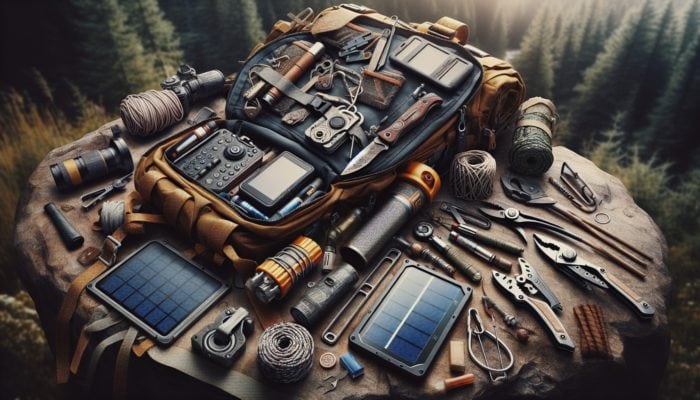Must-Have DIY Survival Tools for Every Adventurer
Effective Water Purification Techniques for Survival

Homemade Survival Gear: Purifying water is a crucial skill that ensures access to safe drinking water in survival situations. By employing simple household items, you can effectively eliminate harmful bacteria and contaminants, making water safe for consumption. One of the most reliable methods is the boiling technique, where you heat water to a rolling boil for at least one minute to kill pathogens. This method is straightforward and does not require any specialised equipment, making it accessible for anyone in a survival scenario.
Another effective technique involves using charcoal, which can be produced by burning wood. Once cooled, crush the charcoal into small pieces and layer it with sand and gravel in a makeshift filter. This filtration system effectively removes impurities, enhancing the water’s taste and clarity, thus making it more palatable and safe to drink.
You can also opt for chemical treatment by using unscented household bleach as a purifying agent. To purify one litre of water, add two drops of bleach, stir it well, and allow it to sit for 30 minutes. If the water still smells like bleach after this time, you may need to repeat the process to ensure all contaminants are eliminated.
When in the wild, a solar still can be a lifesaver. Dig a hole, place a container in the centre, and cover the hole with plastic wrap, securing the edges with stones. As the sun heats the ground, moisture will evaporate, condense on the plastic wrap, and drip into the container, yielding drinkable water that can sustain you in challenging conditions.
- Boiling water for purification
- Utilising charcoal as a filter
- Adding bleach to disinfect
- Constructing a solar still for water collection
Creative Fire Starters from Everyday Materials
Creating fire starters from everyday materials is essential for warmth, cooking, and signalling for help in survival scenarios. One effective way to make a fire starter is by using cotton balls dipped in petroleum jelly. Coat the cotton balls, allow them to harden, and store them in a waterproof container. When you need to use them, pull apart the cotton and ignite it with a spark, providing you with a reliable flame source.
Another popular method involves using egg cartons. Fill the sections of a cardboard egg carton with dryer lint and pour melted wax over them. Once cooled, you can break apart the carton, providing you with several compact fire starters that burn for an extended period, ideal for getting a fire going in challenging conditions.
You can also create fire starters using cardboard tubes from toilet paper rolls. Stuff them with lint or dry grass, dip the ends in wax, and allow them to dry. These are lightweight and easy to carry, making them perfect additions to your survival kit.
Additionally, don’t overlook the utility of tree bark and resin. Certain trees, particularly pines, produce resin that ignites easily and burns hot. Collect small pieces of dry bark and resin to use as natural fire starters, which can be especially effective in damp conditions where finding dry tinder may be a challenge.
- Cotton balls and petroleum jelly
- Cardboard egg cartons filled with lint
- Toilet paper tubes stuffed with dry materials
- Tree bark and resin for natural starters
Constructing Improvised Shelters for Protection
Building an improvised shelter is crucial for protecting yourself from harsh weather elements such as rain, wind, and cold. The first step is to scout your surroundings for resources, such as fallen branches, leaves, and natural features like rocks and hills. A lean-to shelter is one of the simplest and most effective structures you can create using these available materials.
To construct a lean-to, find a long, sturdy branch and prop it against a tree at an angle to create a sloped roof. Then, cover one side with smaller branches, leaves, or grasses to insulate against wind and rain. Ensure you create a dry space on the ground using leaves or pine needles for added comfort and warmth.
If you’re in a region with abundant snow, consider building a quincy, which can provide excellent insulation. To construct a quincy, gather snow and pile it into a mound. Once compacted, carve out a small entrance and hollow out the inside to create a cozy space that can protect you from the elements.
In areas rich in foliage, consider constructing a debris hut. This involves building a frame using branches and then covering it with leaves and moss to create insulation. The key to all these shelters is to ensure they’re raised off the ground and have a solid roof to keep you dry and warm during inclement weather.
- Constructing a lean-to shelter from branches
- Building a quincy in snowy conditions
- Creating a debris hut using foliage
- Insulating your shelter with leaves and moss
Essential First Aid Techniques for Emergencies

Mastering basic first aid techniques can significantly enhance your chances of survival during emergencies. One essential skill is learning how to treat cuts and scrapes using readily available household items. Start by cleaning the wound with fresh water or a saline solution to remove dirt and bacteria. If possible, apply an antiseptic solution, such as diluted hydrogen peroxide or rubbing alcohol, before covering the wound with a clean bandage to prevent infection.
For more severe injuries, such as sprains, using a cold compress is effective. You can create one by wrapping ice in a cloth or using a bag of frozen vegetables. Apply it to the injured area for 15-20 minutes to reduce swelling and alleviate pain, providing much-needed relief.
In the case of insect stings or bites, a paste made from baking soda and water can help alleviate itching and swelling. Apply the paste directly to the sting site and let it sit for 15 minutes before rinsing. For allergic reactions, it’s crucial to have an antihistamine on hand, as well as knowledge of how to use an EpiPen if you’re in a high-risk area.
Lastly, it’s important to learn CPR (Cardiopulmonary Resuscitation). Familiarise yourself with the correct technique, especially the rhythm of compressions and rescue breaths, so that you can respond effectively in critical situations when every second counts.
- Cleansing wounds with saline or water
- Applying a cold compress to treat sprains
- Using a baking soda paste for insect bites
- Learning CPR for emergencies
Insights from Experts on Crafting Homemade Survival Gear
Real-World Examples of Homemade Survival Gear in Action
In numerous survival scenarios, homemade gear has proven to be invaluable. Consider the case of a hiker lost in the wilderness who utilised natural materials to create an effective shelter and fire starter. By foraging for dry leaves and sturdy branches, they constructed a lean-to and used cotton balls from their backpack, mixed with petroleum jelly, to start a fire. This ingenuity kept them warm throughout the night, showcasing the importance of utilising what’s available in your environment.
Another compelling example comes from a group of campers who faced unexpected flooding. Using plastic bags and duct tape, they fashioned improvised dry bags to protect their supplies. This quick thinking allowed them to preserve vital gear and food, demonstrating the efficacy of homemade survival gear in crises.
To replicate these examples, start by assessing your environment for resources. Familiarize yourself with common plants and materials that can be used to create shelters or tools. Practice building your shelter at home before venturing out, and keep a small kit of essential items, such as paracord, duct tape, and a multi-tool, handy, as these can often be repurposed into various survival gear.
- Creating a lean-to shelter for warmth
- Using plastic bags as dry bags
- Repurposing natural materials found in the environment
- Keeping essential tools on hand for versatility
Expert Analysis on the Effectiveness of DIY Survival Tools

Expert survivalists often advocate for creating your own survival gear, as it can be more tailored to individual needs and situations. Many survival experts emphasize the reliability of DIY tools, especially when store-bought options are unavailable. A common recommendation is to focus on multi-purpose tools. For instance, a sturdy knife can serve as a cutting tool, fire starter, and even a makeshift splint when needed.
To improve your DIY gear, consider the following expert recommendations. First, always use high-quality materials; for fire starters, cotton and petroleum jelly provide a long-lasting burn. Second, practice using your gear before it’s needed in a survival scenario. Familiarity breeds confidence, which is crucial when under stress. Third, keep your gear waterproof; using materials like ziplock bags or waterproof containers can protect vital tools from the elements.
Finally, ensure your gear is lightweight and compact, making it easy to carry during hikes or expeditions. By adopting these strategies, you’ll enhance the reliability and effectiveness of your homemade survival tools, ensuring you’re prepared for any situation that may arise.
- Using multi-purpose tools for versatility
- Practicing with your DIY gear to build confidence
- Choosing high-quality materials for durability
- Keeping gear lightweight and compact for easy transport
Step-by-Step Guide to Creating Multi-Purpose Survival Tools
Creating multi-purpose survival tools is a game-changer in enhancing the efficiency of your survival kit. Start with a paracord bracelet, which serves as a wearable survival tool. Not only does it look stylish, but it can be unraveled to provide you with strong cordage for building shelters, securing gear, or even creating fishing lines when needed.
Another excellent example is the combination of a knife and a fire starter. You can create a survival knife that also features a built-in fire starter. Attach a small piece of magnesium rod to the handle; when you need to start a fire, scrape off some magnesium shavings with the knife blade to spark an ember, providing you with a reliable fire source.
Consider a fishing kit that doubles as a sewing kit. Use a small, waterproof container to store fishing hooks, line, and sinkers. Include a few needles and sturdy thread for stitching wounds or repairing gear. This dual-purpose approach minimizes the number of items in your kit while maximizing their utility and versatility.
Lastly, a signal mirror can serve both as a signalling device and a makeshift reflective surface for fire-starting. By polishing a piece of metal or glass, you can effectively signal for help while also having the means to start a fire using sunlight, which can be crucial in emergencies.
- Crafting a paracord bracelet for multiple uses
- Creating a fire-starting knife with a magnesium rod
- Combining fishing and sewing kits in one container
- Making a signal mirror that doubles as a fire starter
What Are the Advantages of Homemade Survival Gear?
How Can Homemade Gear Be Cost-Effective?
Homemade survival gear is often significantly more cost-effective than commercial alternatives. By utilising materials you already have at home or can find in nature, you can substantially reduce expenses. For example, creating a fire starter from cotton balls and petroleum jelly costs just a few pence compared to purchasing commercial fire starters, which can be far more expensive.
Moreover, many DIY projects require minimal investment in materials that serve dual purposes. A water purification system can be constructed using readily available items like charcoal and sand, eliminating the need for costly filtration systems that may not be practical in emergencies.
Furthermore, you can customise your equipment to better fit your specific needs without overspending. This adaptability allows you to maximise functionality while adhering to a budget. Additionally, investing time in crafting your gear can help you develop skills that will pay off in real-world survival situations, making DIY gear not only cost-effective but also a wise investment in your preparedness.
- Using found materials to reduce costs
- Repurposing common household items for gear
- Reducing reliance on expensive commercial alternatives
- Maximising the utility of each item in your kit
What Are the Customisation Benefits of DIY Survival Tools?
One of the greatest advantages of making your own survival gear is the ability to customise it to fit your unique needs. When you create your tools, you can tailor them to suit your environment, personal preferences, and specific survival scenarios. For instance, a shelter constructed from local materials can be designed to withstand the unique weather patterns of your area, providing better protection than a one-size-fits-all commercial tent that may not offer adequate shelter.
Customisation also allows for incorporating personal touches that increase comfort and usability. You can choose the dimensions of your gear to ensure it fits comfortably in your hands or packs. This level of personalization helps improve your efficiency and effectiveness when using the tools during critical moments.
Moreover, DIY gear can be adapted as your skills and knowledge grow. As you learn new techniques or discover different environments, you can modify your equipment accordingly. This adaptability enhances your preparedness and confidence, knowing you have crafted gear that is not just effective but also perfectly aligned with your survival philosophy and approach.
- Tailoring gear to your specific environment
- Incorporating personal preferences into your designs
- Adapting tools as your skills improve
- Maximising comfort and usability in your equipment
Can Homemade Gear Increase Self-Reliance?
Absolutely! Crafting your survival gear fosters a sense of self-reliance that is invaluable in emergencies. By learning to craft your own tools, you become less dependent on commercial products and more attuned to your surroundings. This self-sufficiency encourages creative problem-solving, as you learn to navigate challenges with the resources at your disposal.
The process of creating gear also builds confidence. As you successfully produce and utilise your tools, you reinforce your belief in your abilities. This newfound confidence translates into better decision-making during stressful situations, allowing you to remain calm and focused when it matters most.
Moreover, as you engage in the practice of making gear, you develop a deeper understanding of the materials and techniques involved in survival. This knowledge empowers you to improvise effectively when challenges arise, whether it’s using natural materials for a shelter or creating a fire starter from everyday items. The result is a more self-reliant and capable individual, ready to face any survival situation that may arise.
- Fostering a sense of independence in survival situations
- Building confidence through skill development
- Improving problem-solving capabilities with resourcefulness
- Encouraging creative improvisation with available materials
How Does Homemade Gear Enhance Skill Development?
Creating your survival gear is an excellent way to develop a variety of essential skills that are critical in emergencies. When you engage in DIY projects, you learn practical crafting techniques that enhance your dexterity and hand-eye coordination. These skills can be crucial when you need to create something quickly or repair essential gear in the field, where time and resources may be limited.
Additionally, the process often requires research and planning, which helps improve your critical thinking abilities. As you determine what tools you need and how to construct them, you’re honing your problem-solving skills. This mental exercise prepares you for unexpected challenges during survival situations, enhancing both your cognitive and practical capabilities.
Furthermore, using homemade gear fosters a greater understanding of your environment. By learning to identify useful plants, materials, and resources, you build a connection with nature that becomes invaluable in survival scenarios. This comprehensive skill set establishes a solid foundation that can be built upon as you gain experience and knowledge in the field.
Lastly, you become a more resourceful individual. The ability to adapt and make gear with limited resources is a key survival skill that can be applied in various situations, whether you’re in the wilderness or facing an urban emergency.
- Improving crafting skills and hand-eye coordination
- Enhancing critical thinking through planning and research
- Building an understanding of local resources and materials
- Encouraging resourcefulness in various situations
Food Preservation Techniques for Survival Situations
How to Smoke and Dry Food for Extended Storage
Smoking and drying food are ancient preservation methods that extend the shelf life of your supplies while retaining essential nutrients. To start smoking food, you can create a simple smoker with a few household items. Using a metal container with a lid, place wood chips at the bottom and put your food on a rack above. As the wood burns, it releases smoke, infusing your food with rich flavours while simultaneously killing potential bacteria that could lead to spoilage.
Drying food is another reliable method for preservation. You can use the sun, an oven, or even a dehydrator to remove moisture. To sun-dry fruits and vegetables, slice them thinly and lay them out on a clean screen or mesh. Cover them with a thin cloth to protect against insects. The sun’s heat will gradually remove moisture, allowing the food to be stored for months without refrigeration.
When using an oven, please set it to the lowest temperature and leave the door slightly ajar to allow moisture to escape. Check on the food regularly to prevent overcooking, ensuring it dries evenly without becoming too brittle.
Another option is to invest in a dehydrator, which is an excellent tool for long-term food storage. These devices provide controlled heat and airflow, ensuring even drying of your food. Dehydrated foods can be stored in airtight containers, preserving their nutritional value and flavour for extended periods.
- Creating a simple smoker with metal containers
- Sun-drying fruits and vegetables for preservation
- Using an oven or dehydrator for controlled drying
- Storing dried foods in airtight containers for long-term use
Building a Solar Dehydrator for Sustainable Food Preservation
Constructing a solar dehydrator is a sustainable and cost-effective method for preserving food using the sun’s energy. To create one, gather a few materials: a sturdy frame, mesh screens, and a clear plastic cover. Start by constructing a box frame that allows sunlight to enter from the top and sides. Use wood, metal, or durable plastic, ensuring it’s sturdy enough to hold your food securely.
Next, add mesh screens to the interior to allow air circulation while keeping insects out. Position the dehydrator in a sunny location where it can receive direct sunlight for most of the day, maximising its effectiveness.
You can enhance the efficiency of your solar dehydrator by painting the interior black to absorb more heat. Cover the top with a clear plastic sheet, which helps trap heat and moisture while allowing sunlight to penetrate effectively.
When ready to dry your food, slice it into thin pieces and arrange it on the mesh screens. Monitor the process to ensure the food dries evenly. Depending on the weather, this method can take anywhere from a few hours to a full day, making it a versatile option for preserving a wide range of foods.
Using a solar dehydrator not only preserves food but also harnesses renewable energy, contributing to eco-friendly practices in your survival preparations and ensuring you have sustainable food sources available.
- Constructing a sturdy frame for sunlight exposure
- Using mesh screens for air circulation
- Painting the interior black to enhance heat absorption
- Covering with clear plastic for moisture retention
Fermentation as a Survival Food Preservation Method
Fermentation is a time-honoured method for preserving food while enriching it with beneficial probiotics. This technique not only extends the shelf life of food but also enhances its nutritional value, making it an invaluable skill in survival situations. Many foods are suitable for fermentation, including vegetables, fruits, and dairy products, which can be transformed into delicious, long-lasting provisions.
To ferment vegetables, start with cabbage to create sauerkraut. Shred the cabbage and mix it with salt, then pack it tightly into a clean jar, ensuring it’s submerged in its own juices. Cover the jar with a cloth and let it sit at room temperature for several days to ferment. You’ll know it’s ready when it has a tangy flavour and a slightly fizzy texture, indicating the presence of beneficial bacteria.
Pickles are another excellent option for fermentation. Cucumbers can be fermented in a brine solution with the addition of garlic, dill, and other spices. Use the same method as with sauerkraut, allowing them to ferment for a week or two before consuming, resulting in a crunchy, flavourful snack that can last for months.
Fruits can also be fermented into delicious treats. For instance, making kombucha is a great way to transform tea into a probiotic-rich beverage. Use a SCOBY (symbiotic culture of bacteria and yeast) to initiate the fermentation process, and let it sit for a week to develop flavour, providing you with a refreshing drink that supports gut health.
Fermented foods not only last longer but also contribute positively to gut health, making them invaluable in survival situations where meeting nutritional needs is crucial.
- Creating sauerkraut from cabbage and salt
- Fermenting cucumbers to make pickles
- Using a SCOBY to ferment tea into kombucha
- Exploring a variety of vegetables and fruits for fermentation
Navigation and Signalling Tools for the Wilderness
How to Create a Compass Using a Needle and Magnet
Crafting a compass is a simple yet effective way to navigate when lost in the wilderness. To make a basic compass, you will need a needle, a magnet, and a small container of water. Start by magnetizing the needle by stroking it with a magnet in one direction, approximately 30 to 40 times. This process aligns the needle’s molecules, allowing it to respond accurately to the Earth’s magnetic field.
Next, find a small piece of cork or foam to float the needle on. Carefully insert the magnetised needle into the cork and place it in a bowl of water. As the needle floats, it will align itself along the North-South axis, allowing you to determine direction effectively.
This homemade compass is particularly useful in wilderness scenarios where traditional navigation tools may be unavailable. When combined with basic map-reading skills, this can help you plot routes effectively and navigate confidently through unfamiliar terrain.
To enhance the accuracy of your compass, make sure that you are away from metal objects and electronic devices, which can interfere with its magnetic reading. With practice, you can master using your compass for navigation, significantly increasing your confidence in outdoor adventures.
- Using a needle and a magnet to create a compass
- Floating the needle on a cork in water for stability
- Ensuring accurate readings by avoiding metal and electronics
- Practicing compass navigation techniques in various conditions
Creating a Signal Mirror for Emergency Situations
A signal mirror is an effective tool for attracting attention and signalling for help during emergencies. You can easily create one using a piece of reflective material, such as glass or aluminium foil. Start by cutting the material into a manageable size, approximately 3 x 5 inches, for easy handling and portability.
To increase visibility, ensure that the reflective surface is clean and shiny. If using glass, polish it to maximise reflectivity. For aluminium foil, smooth out wrinkles to create a flat surface that will effectively reflect sunlight.
In practice, to use your signal mirror, position it to catch sunlight, directing the beam towards your target—whether that’s a passing aircraft or a distant search party. Practising this technique during daylight hours can ensure you can successfully signal when the need arises, increasing your chances of being rescued.
Consider adding a bright colour to the back of your mirror, such as orange or yellow, which can help make it more visible against natural backgrounds. A signal mirror can be a lifesaver in remote areas where traditional means of signalling are unavailable, so having one on hand is essential for any survival kit.
- Cutting reflective material into manageable sizes
- Polishing glass or smoothing aluminium foil for effectiveness
- Practising directing sunlight towards potential rescuers
- Using bright colours on the back for increased visibility
Improvised Map-Making Techniques for Navigation
Creating a map in unfamiliar terrain is crucial for navigation and planning your escape route. To make an improvised map, begin by gathering natural materials such as charcoal, mud, or sand. Find a flat surface, like a piece of bark or a large leaf, and use charcoal or mud to draw out the contours of the area, marking significant landmarks like rivers, mountains, or caves.
When sketching, pay attention to the scale; use a rough estimation of distances between points to provide a useful guide for navigation. Add notes regarding important resources such as water sources or potential shelter locations. The more detail you can incorporate, the better your chances of using it effectively in a survival scenario.
If you have access to paper or a notepad, create a more permanent map by sketching it out, ensuring you include a compass rose for orientation. This permanent record can serve as a reliable guide during your journey.
Finally, always carry a small pencil or pen in your survival kit, which can help you create clear and accurate maps. This skill not only helps in navigation but also boosts your confidence in unfamiliar environments, enhancing your overall preparedness.
- Using charcoal or mud to draw terrain outlines
- Marking significant landmarks and resources on your map
- Estimating distances accurately for better navigation
- Carrying a pencil or pen for permanent mapping
Using Whistles and Other Audible Signals for Rescue
Audible signals play a vital role in attracting attention during rescue situations. A whistle is one of the most effective tools you can carry, as it can be heard from long distances, even in noisy environments, without exhausting your voice. Select a whistle that is both lightweight and durable, ideally one that can withstand the elements.
To signal for rescue, use a standard pattern of three short blasts, which is universally recognised as a distress signal. Repeat this pattern intermittently to conserve your energy while maximising visibility and increasing your chances of being noticed by potential rescuers.
In addition to whistles, consider utilising other audible signals, such as bells or even creating noise with natural materials. For instance, you can tie a few small rocks together to create a makeshift rattle, which can be used to signal your location effectively.
Another technique is to use sound-making objects in conjunction with visual signals, such as smoke from a fire or brightly colored materials. This multi-sensory approach increases your chances of being noticed by rescuers, adding another layer of safety to your survival strategy.
- Carrying a durable whistle for long-distance signalling
- Using a three-blast pattern for distress signals
- Creating noise with rocks or other materials
- Combining audible signals with visual cues for effectiveness
How to Maintain and Repair Your Survival Gear
Basic Repair Techniques for Fabric and Clothing
Maintaining and repairing fabric gear is crucial for ensuring its longevity and functionality in survival situations. Simple sewing skills can go a long way in reinforcing or patching up clothing, tents, and other fabric items. A basic needle and thread can help repair torn seams or small holes. Before you begin, ensure the fabric is clean and dry to facilitate easier repairs and prevent further damage.
For larger tears, consider using fabric patches to repair the damage. Cut a patch from durable fabric, ideally the same color or a similar material to the original item. Sew the patch over the damaged area, ensuring that you reinforce the edges to prevent further tearing and extend the gear’s lifespan.
If you have access to duct tape, it can serve as a temporary fix for fabric items. Apply a strip over the tear, smoothing it down to create a waterproof seal. This quick solution can get you through critical times until a more permanent repair can be made.
Additionally, for outdoor gear, regularly inspect fabric items for wear and tear, especially around seams and high-stress areas. Preventive maintenance can save you time and resources in the long run, ensuring your gear remains in top condition when you need it most.
- Using a needle and thread for basic fabric repairs
- Applying fabric patches for larger tears
- Utilising duct tape as a temporary fix
- Regularly inspecting gear for wear and tear
Maintaining Waterproofing on DIY Gear
Waterproofing is essential for survival gear, especially in wet environments where moisture can compromise the integrity of your items. To maintain waterproofing, start by selecting the right materials; choose fabrics with inherent waterproof properties, such as nylon or treated canvas, that can withstand exposure to the elements.
If you have gear that requires treatment, waterproofing sprays can be applied to create a protective barrier. Ensure the surface is clean before applying the spray, then apply it evenly and allow it to dry completely. This treatment can help repel water and extend the life of your gear, ensuring you remain dry when it matters most.
For homemade shelters, consider using a tarp or waterproof canvas as a roof. Regularly check for holes or tears, and patch them immediately to prevent leaks and maintain the structure’s integrity. When storing gear, ensure it is kept in a dry, cool place, away from direct sunlight, which can degrade waterproof materials over time.
Additionally, familiarise yourself with techniques for sealing seams, such as using seam tape or silicone sealant, to enhance waterproofing. These steps will ensure your gear remains reliable, no matter the conditions you face.
- Selecting waterproof materials for gear construction
- Applying waterproofing sprays for added protection
- Using tarps or waterproof canvas for shelters
- Sealing seams with tape or silicone for durability
Repairing and Sharpening Tools and Weapons
Keeping tools and weapons in peak condition is crucial for survival scenarios. Regular maintenance not only extends their life but also ensures they function effectively when you need them the most. For sharpening knives and other cutting tools, a sharpening stone or honing rod will be your best friend. Start by holding the blade at a 20-degree angle against the stone, applying even pressure as you slide the blade across the surface in a sweeping motion to ensure a sharp edge.
For larger tools, such as axes or machetes, use a file to grind down nicks and dull edges. After sharpening, wipe down the blade to remove any metal shavings and apply a light coat of oil to prevent rust and maintain the blade’s integrity.
Regularly inspect tools for any loose parts or damage. If you notice a handle coming off, use wood glue and clamps to secure it. For small fixes, duct tape can serve as a temporary solution until you have the chance to perform a proper repair.
Lastly, always keep your tools clean and lubricated to ensure their longevity and functionality. This proactive approach can make a significant difference when you’re relying on them in critical moments, ensuring you have dependable tools at your disposal.
- Using sharpening stones for blades and tools
- Employing files for larger cutting tools
- Inspecting tools for loose parts and damage
- Cleaning and lubricating tools regularly for longevity
Cleaning and Lubricating Mechanical Parts of a Gear
The mechanical components of your survival gear, such as hinges, locks, and moving parts, require regular cleaning and lubrication to maintain their optimal functionality. Dust, mud, and grime can accumulate, causing components to wear out prematurely. Start by disassembling the parts if necessary, and use a soft brush or cloth to wipe away debris, ensuring everything operates smoothly.
For lubrication, apply a light oil, such as machine oil or vegetable oil, to moving parts. This will prevent rusting and ensure smooth operation. Avoid using too much oil, as excess can attract dirt and debris, leading to further issues down the line.
When cleaning, be sure to check for signs of wear or damage. If you notice parts that have become loose, consider tightening screws or replacing worn components. For tools like folding knives, ensure the pivot point is free of obstruction to allow for easy opening and closing when needed.
Lastly, creating a maintenance schedule for your gear can help you stay organised and proactive. Regularly check mechanical parts after each use or at least once a month to ensure they are functioning correctly. This diligence will keep your gear ready for action when you need it the most.
- Cleaning mechanical parts with a soft brush or cloth
- Applying light oil for lubrication
- Checking for wear and tightening screws when necessary
- Creating a maintenance schedule for gear inspection
Inspecting and Replacing Worn Components for Reliability
Regular inspections of your survival gear are essential for ensuring its reliability and functionality. Start by examining the stitching on fabric items, checking for frays or tears that may compromise their strength. If you find any, address them immediately by sewing or patching to prevent further damage and ensure your gear remains dependable.
For components such as buckles, zippers, and straps, look for signs of wear or damage. If any part is compromised, replace it with a durable alternative to maintain the integrity of your gear. Keep a small kit with spare parts and tools handy in your survival gear to facilitate quick repairs in the field.
Additionally, inspect tools for rust or corrosion, especially on metal components. Clean these areas with a rust remover, then apply oil to protect against future wear and ensure your tools remain in good working condition.
Incorporating preventive measures such as careful storage and regular maintenance checks will ensure that your gear remains functional and reliable. This proactive approach to inspection and replacement ultimately enhances your preparedness and confidence in survival situations.
- Examining stitching for frays and tears
- Replacing worn buckles, zippers, and straps
- Cleaning rust and applying protective oil
- Maintaining a kit of spare parts for quick repairs
Research-Backed Benefits of Homemade Survival Gear
Expert Analysis on the Psychological Benefits of DIY Survival Gear
Creating your own survival gear has profound psychological benefits that can enhance resilience and preparedness. Engaging in DIY projects fosters a sense of achievement and empowerment, as you take control of your survival preparations. This proactive mindset can significantly reduce anxiety and boost confidence, knowing you’ve equipped yourself with the tools necessary to navigate unexpected situations.
Moreover, the process of making gear often involves problem-solving and critical thinking, which can improve cognitive flexibility. As you learn to adapt materials and techniques, you develop a mindset better equipped to handle challenges. This adaptability translates to improved mental resilience when faced with stressful situations, making you more capable in emergencies.
Additionally, crafting gear can provide a sense of connection to nature, reinforcing a deeper appreciation for one’s environment. This connection can lead to enhanced focus and clarity, further preparing you mentally for survival scenarios. By building your survival gear, you not only equip yourself physically but also cultivate a robust psychological foundation essential for thriving in challenging situations.
- Boosting confidence through self-made gear
- Enhancing problem-solving skills with crafting
- Creating a connection to nature through DIY projects
- Reducing anxiety by taking control of survival preparations
Real-World Examples of DIY Gear Outperforming Commercial Options
There are numerous instances where homemade survival gear has outperformed commercial products. One notable example involves a hiker who, faced with unexpected rain, used a homemade tarp shelter crafted from a large garbage bag. In contrast, others struggled with expensive, bulky tents that failed to keep them dry. This resourcefulness highlighted the effectiveness of DIY solutions in unpredictable weather conditions, proving that adaptability is key in survival scenarios.
Another example is the use of DIY fire starters made from common materials, such as cotton balls and petroleum jelly. Adventurers have reported higher success rates with these homemade fire starters compared to commercial options, especially when needing to ignite wet wood that would otherwise be difficult to light.
Similarly, many survivalists have found that homemade water purification systems, utilising simple filters made from charcoal and sand, often perform just as well, if not better, than store-bought filters. This hands-on approach enables users to tailor their gear to specific conditions, demonstrating that customization can lead to better outcomes in survival situations.
These real-world examples illustrate the effectiveness of thoughtful, homemade survival gear, emphasising the importance of adaptability and resourcefulness in overcoming challenges while enhancing your chances of survival.
- Homemade tarp shelters outperform commercial tents.
- DIY fire starters, igniting wet wood more effectively
- Water purification systems tailored to specific conditions
- Resourcefulness leading to better survival outcomes
Actionable Steps for Integrating Homemade Gear into Your Survival Kits
Integrating homemade gear into your existing survival kit can enhance its effectiveness and versatility. Start by assessing your current kit to identify areas where you can substitute or augment with homemade solutions. For example, replace store-bought fire starters with DIY options, such as cotton balls dipped in petroleum jelly, which are lightweight, easy to make, and highly effective.
Incorporate multi-purpose tools, such as a paracord bracelet that can unravel into cordage, into your kit to save space while maximising functionality. Additionally, consider adding a small solar dehydrator to your food preservation section, allowing you to extend the shelf life of your supplies seamlessly and sustainably.
It’s also important to create a designated section in your kit for homemade gear, ensuring that you can quickly access these items when needed. Keep a list of your homemade items and their uses, so you’re familiar with how to deploy them effectively in emergencies, enhancing your preparedness.
Lastly, regularly practice using your homemade gear in various scenarios. This hands-on experience will boost your confidence and ensure that you are prepared to utilise your gear effectively when it matters most, making you a more capable survivor in critical situations.
- Assessing your current kit for potential upgrades
- Incorporating multi-purpose tools for versatility
- Creating a designated section for homemade gear
- Practicing with your homemade gear regularly for confidence
Frequently Asked Questions (FAQs)
What is homemade survival gear?
Homemade survival gear consists of tools and equipment crafted from readily available materials to aid in survival situations. This can include anything from fire starters to shelters, created using DIY techniques that enhance your preparedness and emergency readiness.
Why is it important to create your own survival gear?
Creating your own survival gear allows for customisation, cost-effectiveness, and adaptability to specific environments or situations, significantly enhancing your chances of survival when faced with unexpected challenges.
How can I purify water using homemade methods?
You can purify water by boiling it, using charcoal as a filter, or treating it with unscented bleach. These methods effectively eliminate harmful pathogens, making water safe to drink in survival scenarios.
What are some effective DIY fire starters?
Effective DIY fire starters include cotton balls dipped in petroleum jelly, cardboard egg cartons filled with dryer lint, and toilet paper tubes stuffed with dry grass or lint, all of which are easy to make and use.
How do I build a shelter in a survival situation?
To build a shelter, use available materials like branches and leaves to create a lean-to or debris hut. Ensure it’s insulated and has a solid roof to protect against the elements, providing you with a safe space.
What basic first aid skills should I know?
Essential first aid skills include cleaning wounds, applying bandages, using cold compresses for injuries, and knowing CPR techniques for emergencies, all of which can significantly improve survival chances.
How can I preserve food for long-term storage?
Food can be preserved through various methods, including smoking, drying, and fermentation. Techniques such as using a solar dehydrator or creating pickles and fermented vegetables can significantly extend shelf life, ensuring you have food when needed.
What navigation tools can I create?
You can create a compass using a magnetised needle and a bowl of water. Other tools include signal mirrors and improvised maps made from natural materials, all of which enhance your navigation skills in the wilderness.
How do I maintain survival gear?
Maintain survival gear by regularly inspecting it for wear, cleaning and lubricating mechanical parts, and repairing any damage promptly to ensure functionality and reliability when you need it most.
What psychological benefits come from making your own gear?
Making your own gear enhances self-reliance, builds confidence, and fosters a proactive mindset. These benefits contribute to improved mental resilience in survival situations, equipping you to handle challenges more effectively.
Explore our journey on X!
Surviving Without Fuel: Essential Strategies
Exploring the Fundamentals of Fuel-Free Living What Is the Concept of Living Without Fuel? Surviving Without Fuel: The concept of living without fuel centers on the pivotal goal of significantly reducing or entirely eliminating our dependence on conventional energy sources, such as gasoline and diesel. This lifestyle choice underscores the importance of adopting sustainable alternatives […]
Grid-Down Survival: Essential Strategies for Resilience
Effective Strategies for Preparing for Grid-Down Scenarios Building a Comprehensive Stockpile of Essential Supplies Grid-Down Survival: To thrive during a grid-down scenario, building a comprehensive stockpile of essential supplies is crucial for your survival and that of your family during prolonged power outages. The strategy involves gathering a diverse assortment of items that meet fundamental needs such […]
Prepper Relocation Guide: Universal Strategies
Crucial Factors to Consider When Relocating for Preparedness Key Influences on Relocation Choices Prepper Relocation Guide: When contemplating a relocation for preparedness, it is essential to conduct a detailed assessment of various personal and situational elements. One of the primary considerations is to evaluate individual needs and preferences. These can encompass factors such as family […]
Prepper Community Tips: Essential Strategies for Preparedness
Establishing a Resilient Prepper Network for Effective Collaboration How Can You Evaluate the Trustworthiness of Potential Prepper Allies? Prepper Community Tips: Establishing a network of trustworthy preppers is paramount for building a reliable community. The cornerstone of any robust prepper group is trust, which is nurtured through consistent actions and demonstrated levels of preparedness. Engaging […]








Your post on essential DIY survival tools resonates deeply with me, especially the emphasis on water purification techniques. I recently tried out the boiling method during a weekend camping trip and was amazed at how straightforward yet effective it was. I love how accessible these techniques are—anyone can find a way to ensure they have safe drinking water in the great outdoors.